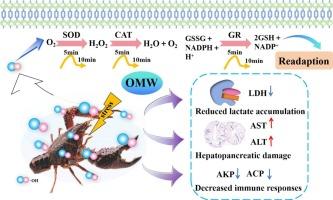臭氧微纳泡和超声清洗对小龙虾生理代谢反应的比较研究。
IF 9.7
1区 化学
Q1 ACOUSTICS
引用次数: 0
摘要
在加工前保持活水产品的健康是保证最佳食品质量的关键。研究了臭氧微纳泡洗(OMW)和超声波清洗对小龙虾(中国最具经济价值的淡水水产品之一)健康状况的不同影响。研究发现,OMW是一种更温和、更有效的替代传统超声洗涤(UW)的方法,可以减少物理损伤,从而增强小龙虾的活力,提高肠道内容物排出率,改善小龙虾加工前的表面清洁度。这些改进是由于气泡收缩和破裂产生的物理力比UW的空化和机械效应更温和。此外,UW强烈的空化、机械和热效应破坏了小龙虾的抗氧化系统,导致肝胰脏严重损伤,丙氨酸转氨酶和天冬氨酸转氨酶活性显著升高。此外,OMW显著降低了乳酸脱氢酶活性,减少了氧化应激引起的乳酸积累,从而预防了小龙虾的酸中毒。这些结果表明,OMW是一种更温和但更有效的方法,可以改善活水产品的健康状况,从而在加工成食品之前保持其活力和质量,这表明其作为一种预处理技术在水产食品工业中的应用潜力巨大。本文章由计算机程序翻译,如有差异,请以英文原文为准。

Comparative study on physiological and metabolic responses of crayfish to ozone micro-nano bubbles and ultrasound washing
Maintaining the well-being of living aquatic products before processing is crucial to guarantee best food quality. This study investigated the different effects of ozone micro-nano bubbles washing (OMW) and ultrasound washing on the well-being of living crayfish, one of the most economically valuable freshwater aquatic products in China. It has been found that OMW was a gentler and more effective alternative to traditional ultrasonic washing (UW) that reduced physical damage, thus leading to enhanced living vitality, increased intestinal content evacuation rate, and improved surface cleanliness of crayfish before processed as aquatic food. These improvements were attributed to the milder physical force generated by bubbles contraction and collapse than the cavitation and mechanical effects of UW. In addition, the strong cavitation, mechanical, and thermal effects of UW impaired the antioxidant system of crayfish, leading to the severe hepatopancreas damage as indicated by the substantially elevated activities of alanine aminotransferase and aspartate aminotransferase. Moreover, OMW significantly lowered the lactate dehydrogenase activity and reduced lactic acid accumulation due to decreased oxidative stress, thereby preventing acidosis in crayfish. These findings demonstrated that OMW was a milder yet more effective approach to improve the well-being of living aquatic products, thus maintaining their vitality and quality prior to processing into foods, suggesting its great potential as a pretreatment technology for applications in the aquatic food industry.
求助全文
通过发布文献求助,成功后即可免费获取论文全文。
去求助
来源期刊

Ultrasonics Sonochemistry
化学-化学综合
CiteScore
15.80
自引率
11.90%
发文量
361
审稿时长
59 days
期刊介绍:
Ultrasonics Sonochemistry stands as a premier international journal dedicated to the publication of high-quality research articles primarily focusing on chemical reactions and reactors induced by ultrasonic waves, known as sonochemistry. Beyond chemical reactions, the journal also welcomes contributions related to cavitation-induced events and processing, including sonoluminescence, and the transformation of materials on chemical, physical, and biological levels.
Since its inception in 1994, Ultrasonics Sonochemistry has consistently maintained a top ranking in the "Acoustics" category, reflecting its esteemed reputation in the field. The journal publishes exceptional papers covering various areas of ultrasonics and sonochemistry. Its contributions are highly regarded by both academia and industry stakeholders, demonstrating its relevance and impact in advancing research and innovation.
 求助内容:
求助内容: 应助结果提醒方式:
应助结果提醒方式:


